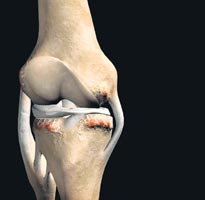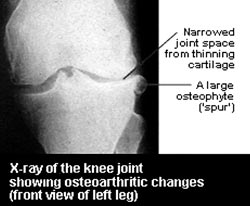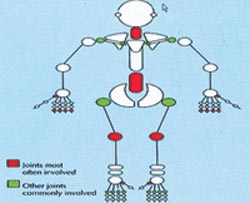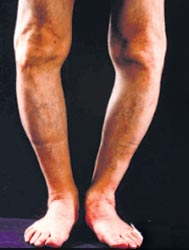
When your knees acheBy Dr. Kaleel CassimOsteoarthritis is a disease which affects the joints in the body. 'Osteo' means bone and 'arthritis' means joint damage and swelling (inflammation). The surface of the joint is damaged and the surrounding bone grows thicker. When joints are swollen and damaged, they can be painful and difficult to move. Osteoarthritis is also known as 'osteoarthrosis', 'arthrosis' and 'degenerative joint disease'.What causes osteoarthritis of the knee?Many factors seem to increase the risk of osteoarthritis developing in the knee joint. The risk does increase as we get older, but osteoarthritis of the knee joint is something that runs in some families.This may be linked with a gene that affects collagen, one of the main building blocks of cartilage.
Osteoarthritis of the knee is twice as common in women as in men. It mainly occurs in women who are over the age of 50, and is often associated with mild arthritis of the joints at the end of the fingers(causing bony swellings called Heberden's nodes). Osteoarthritis of the knee is common in people who are overweight, especially in middle-aged women. Being overweight also increases the chances of osteoarthritis getting worse once it has developed. Putting regular stress on the knee joint can lead to osteoarthritis. People who run and jog for a long time have a slightly increased risk of osteoarthritis of the knee. Injuries to the knee joint often lead to osteoarthritis in later life. Does osteoarthritis of the knee vary for different people? Osteoarthritis of the knee affects different people in different ways. Some people have a problem only with one knee, others with both. Pain is the main problem for some while others find their main problem is difficulty in walking. Some people may stay the same for many years while the osteoarthritis in other people keeps getting worse.
How can I tell if I have osteoarthritis of the knee? People with osteoarthritis of the knee joint usually complain that the knee is painful or aching. Your knee joint may often feel stiff at certain times. You may have pain all around the joint or just in one particular place, and the pain may be worse after a certain activity. The pain is usually better when you rest. It is unusual to have pain in the knee joint which wakes you up at night, except in severe osteoarthritis. You may feel stiff for a short period after resting and first thing in the morning. Walking for a few minutes usually eases the stiffness.
You will probably find that your pain will vary.There may be good days and bad days or even good and bad months for no apparent reason. Changes in the weather may make a difference. For example, your joints may ache more just before it rains. All joints have nerve endings which are sensitive to pressure. The nerve endings will respond to the drop in atmospheric pressure which occurs before it rains. If you develop more severe arthritis, your movement will be restricted. Walking any distance or climbing stairs can be a problem. Sometimes your knee joint may give way because of weak thigh muscles or damaged ligaments. How do rheumatologists diagnose osteoarthritis of the knee? When your joints are examined, your doctor can feel the bony swelling and creaking of the joint and see any restricted movement. Your rheumatologist will also be looking for tenderness over the joint and any extra fluid. The thigh muscles are usually thinner and weaker than normal. With very severe osteoarthritis in the knee, the knee joint will tend to give way because of the damaged ligaments. What tests can show osteoarthritis? The x-ray is the most useful test to confirm osteoarthritis. Often it will show the space between the bones narrowing as the cartilage thins, and changes in the bone such as spurs. Calcification may also show on knee x-rays. How can osteoarthritis of the knee be treated? There are no cures for osteoarthritis.But there are many treatments that can help to:
Can drugs help? At the moment, there are no drugs which affect how osteoarthritis develops. But some drugs can help you deal with the symptoms. Pain relievers (such as paracetamol) and anti-inflammatory creams to rub into the knee can help pain and stiffness. Some people find them more helpful than others. Anti-inflammatory drugs (NSAIDs) help some people more than paracetamol but they can cause stomach ulcers. Discuss this with your rheumatologist. Sometimes an injection might help, either into a tender spot around the knee, or even into the joint itself. Recently there has been a lot of interest in a nutritional supplement called glucosamine sulphate. These are now referred to as disease modifying osteoarthritic drugs (DMOADs) or chondroprotective agents. Some patients seem to benefit from them and if so, it's worthwhile taking them. Can surgery help? Most people with osteoarthritis of the knee will never need surgery. But operations are sometimes used for badly damaged joints. These include joint replacement. This will be considered for someone who is barely able to walk and who is in constant pain. What can I do to help myself? You can make a major difference to your arthritis of the knees in two ways: (1) Lose weight (if overweight). (2) Quadriceps (thigh muscle) exercises. Which exercises are best? Straight-leg raise - sitting: The most important thing is to choose exercises which you can do regularly. The easiest to do is when sitting down in a chair. Get into the habit of doing this every time you sit.
Sit well back in the chair with a good posture. Straighten and raise the leg, hold it for a slow count to ten, then slowly lower it. Repeat this several times with each leg - at least ten times with each. If this can be done easily, repeat the exercises with a weight on the ankle (buy ankle weights from a sports shop or improvise with a tin of e.g. peas in a carrier bag wrapped around the ankle). Straight-leg raise - lying: Get into the habit of doing straight-leg exercises in the morning and at night whilst lying in bed. With one leg bent at the knee, hold the other leg straight and lift the foot just off the bed. Hold for a slow count of five then lower. Repeat with each leg five times every morning and evening. Muscle stretch: At least once a day when lying down, do the following exercise. First, place a rolled-up towel under the ankle of the leg to be exercised. Then bend the other leg at the knee. In the leg to be exercised, use your leg muscles to push the back of the knee firmly towards the bed or the floor. Hold for a slow count of five. Repeat with each leg five times. Not only does this exercise help to strengthen the quadriceps muscles, it also prevents the knee from becoming permanently bent. Clenching exercises: During the day, get into the habit of clenching and releasing the quadriceps muscles. By constantly stimulating the muscles, they become stronger. What else can I do?
What are the prospects if I have osteoarthritis of the knee? Osteoarthritis does not always get worse. Most people with osteoarthritis carry on a normal life and do not become severely disabled. For many people, osteoarthritis reaches a peak a few years after the symptoms start and then either stays the same or gets a little easier. However, osteoarthritis of the knee can often worsen as the years go by, and may become painful and disabling. Sometimes osteoarthritis gets better on its own, but this is unusual. However, regular appropriate exercise, protecting the joints from further injury, and maintaining an ideal weight through healthy eating will all help. So, to a certain extent, the person with osteoarthritis is in control of the outcome in their own case. (The writer is Consultant Rheumatologist, Sri Jayewardenepura General Hospital) |
|| Front
Page | News | Editorial | Columns | Sports | Plus | Financial
Times | International | Mirror | TV
Times | Funday
Times | MediScene || |
| |
Copyright
2007 Wijeya
Newspapers Ltd.Colombo. Sri Lanka. |



